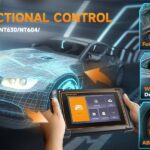Leaving an OBD2 scanner plugged into your car’s OBD2 port while driving is a common question among car owners. The short answer is yes, in most cases, you can. However, there are several factors to consider regarding safety, potential battery drain, and best practices. This article will explore the pros and cons of driving with an OBD2 scanner connected, address common concerns, and offer expert advice to help you make informed decisions.
Why Drive with an OBD2 Scanner Connected?
Real-time vehicle monitoring is the primary benefit. A connected OBD2 scanner provides a continuous stream of data about your car’s performance, allowing you to:
- Diagnose Issues: Identify problems as they occur, potentially preventing minor issues from becoming major repairs.
- Monitor Performance: Track parameters like speed, RPM, coolant temperature, and fuel efficiency to understand your car’s behavior.
- Receive Immediate Alerts: Get notified instantly of any diagnostic trouble codes (DTCs) or malfunctions, even before the check engine light illuminates.
- Improve Fuel Efficiency: Analyze driving habits and make adjustments to optimize fuel consumption.
Potential Drawbacks of Driving with OBD2 Scanner
While generally safe, there are some potential downsides to consider:
- Battery Drain: Although modern scanners consume minimal power, leaving a scanner plugged in continuously, especially in older vehicles or with low-quality scanners, can drain the battery over time, particularly if the vehicle is not driven frequently.
- Distraction: Constantly monitoring data from the scanner while driving can be distracting and potentially dangerous. Avoid interacting with the scanner while the vehicle is in motion.
- Device Malfunction: While rare, a malfunctioning scanner could potentially interfere with the vehicle’s electronic systems. Choose a reputable brand and ensure the scanner’s firmware is up to date.
Expert Recommendations and Safety Precautions
Mechanics and automotive experts generally advise:
- Use a High-Quality Scanner: Invest in a reliable OBD2 scanner from a reputable manufacturer to minimize the risk of malfunction and ensure accurate data.
- Monitor Battery Health: Regularly check your car battery’s voltage, especially if leaving the scanner connected for extended periods.
- Avoid Distractions: Do not interact with the scanner while driving. Configure the device to minimize alerts and notifications while the vehicle is in motion.
- Update Firmware: Keep your scanner’s firmware updated to ensure compatibility and optimal performance.
Conclusion
Driving with an OBD2 scanner plugged in can be a valuable tool for monitoring your vehicle’s health and performance. By understanding the potential drawbacks and following the recommended safety precautions, you can utilize the benefits of real-time diagnostics without compromising safety or risking damage to your vehicle. Remember to prioritize safe driving habits and avoid interacting with the scanner while the car is in motion.

